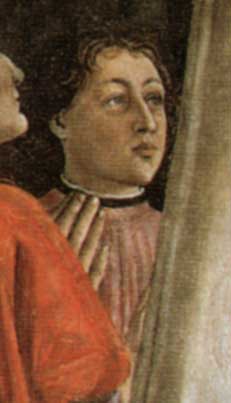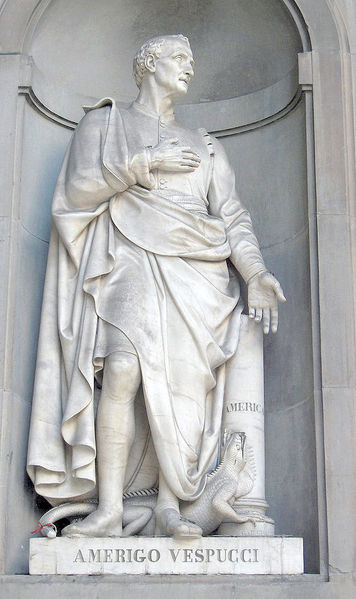<Back to Index>
- Cosmonaut Yuri Alekseyevich Gagarin, 1934
- Painter Aleksander Orłowski, 1777
- Explorer Amerigo Vespucci, 1454


Amerigo Vespucci (Firenze, March 9, 1454 – Sevilla, February 22, 1512) was an Italian explorer, navigator and cartographer. The continent of America is popularly believed to have derived its name from the feminized Latin version of his first name.
Amerigo Vespucci was born and brought up by his uncle in the Republic of Florence in what is now Italy. Vespucci was born in Montefioralle, a small village near Greve in Chianti, south of Florence. He worked for Lorenzo de' Medici and his son, Giovanni. In 1492 he was sent to work at the agency of Medici bank in Seville, Spain.
At the invitation of king Manuel I of Portugal, Vespucci participated as observer in several voyages that explored the east coast of South America between 1499 and 1502. In 1500 that King's commander, Pedro Álvares Cabral, on his way to the Cape of Good Hope and India, had discovered Brazil at latitude 16°52'S. Portugal claimed this land by the Treaty of Tordesillas, and the King wished to know whether it was merely an island or part of the continent Spanish explorers had encountered farther north. Vespucci, having already been to the Brazilian shoulder, seemed the person best qualified to go as an observer with the new expedition Manuel was sending. Vespucci did not command at the start - the Portuguese captain was probably Gonçalo Coelho - but ultimately took charge at the request of the Portuguese officers. Vespucci, in all probability, voyaged to America at the time noted, but he did not have command and as yet had no practical experience piloting a ship. On the first of these voyages he was aboard the ship that discovered that South America extended much further south than previously thought. The expeditions became widely known in Europe after two accounts attributed to Vespucci were published between 1502 and 1504. In 1507, Martin Waldseemüller produced a world map on which he named the new continent America after Vespucci's first name, Amerigo. In an accompanying book, Waldseemüller published one of the Vespucci accounts, which led to criticism that Vespucci was trying to upset Christopher Columbus' glory. However, the rediscovery in the 18th century of other letters by Vespucci, primarily the Soderini Letter, has led to the view that the early published accounts could be fabrications, not by Vespucci, but by others.
In 1503 Amerigo sailed in Portuguese service
again to Brazil, but this expedition failed to make new discoveries.
The fleet broke up, the Portuguese commander's ship disappeared, and
Vespucci could proceed only a little past Bahia before returning to
Lisbon in 1504. He did not sail again, and as there seemed no more work
for him in Portugal he returned to Seville, where he settled
permanently and where he had earlier married Maria de Cerezo. He was
middle-aged, and the fact that there were no children might indicate
that Maria was also past her youth. In 1508, after only two voyages to the Americas, the position of chief of navigation of Spain (piloto mayor de Indias) was created for Vespucci, with the responsibility of planning navigation for voyages to the Indies. Two letters attributed to Vespucci were published during his lifetime. Mundus Novus (New World) was a Latin translation of a lost Italian letter sent from Lisbon to Lorenzo di Pierfrancesco de' Medici. It describes a voyage to South America in 1501-1502. Mundus Novus was published in late 1502 or early 1503 and soon reprinted and distributed in numerous European countries. Lettera di Amerigo Vespucci delle isole nuovamente trovate in quattro suoi viaggi (Letter of Amerigo Vespucci concerning the isles newly discovered on his four voyages), known as Lettera al Soderini or just Lettera, was a letter in Italian addressed to Piero Soderini. Printed in 1504 or 1505, it claimed to be an account of four voyages to
the Americas made by Vespucci between 1497 and 1504. A Latin
translation was published by the German Martin Waldseemüller in 1507 in Cosmographiae Introductio, a book on cosmography and geography, as Quattuor Americi Vespuccij navigationes (Four Voyages of Amerigo Vespucci). In 1508, King Ferdinand made
Vespucci chief navigator of Spain at a huge salary and commissioned him
to found a school of navigation, in order to standardize and modernize
navigation techniques used by Iberian sea captains then exploring the
world. Vespucci even developed a rudimentary, but fairly accurate
method of determining longitude (which only more accurate chronometers
would later improve upon). In
the 18th century three unpublished familiar letters from Vespucci to
Lorenzo de' Medici were rediscovered. One describes a voyage made in
1499-1500 which corresponds with the second of the "four voyages".
Another was written from Cape Verde in
1501 in the early part of the third of the four voyages, before
crossing the Atlantic. The third letter was sent from Lisbon after the
completion of that voyage.` Some
have suggested that Vespucci, in the two letters published in his
lifetime, was exaggerating his role and constructed deliberate
fabrications. However, many scholars now believe that the two letters
were not written by him but were fabrications by others based in part
on genuine letters by Vespucci. It was the publication and widespread
circulation of the letters that might have led Martin Waldseemüller to name the new continent America on his world map of 1507 in Lorraine. Vespucci used a Latinised form of his name, Americus Vespucius, in his Latin writings, which Waldseemüller may have used as a base for the new name, taking the feminine form America. Amerigo itself is an Italian form of the medieval Latin Emericus, which through the German form Heinrich (in English, Henry) derived from the Germanic name Haimirich. But it might be Waldseemüller who named the continent after Richard Ameryk, who was the principal owner of John Cabot's ship Matthew during his voyage of exploration to North America in 1497. He died on February 22, 1512 in Seville, Spain. First Voyage A
letter published in 1504 purports to be an account by Vespucci, written
to Soderini, of a lengthy visit to the New World, leaving Spain in May
1497 and returning in October 1498. However, modern scholars have
doubted that this voyage took place, and consider this letter a forgery. Whoever did write the letter makes several observations of native customs, including use of hammocks and sweat lodges. Second Voyage About the 1499–1500, Vespucci joined an expedition in the service of Spain, with Alonso de Ojeda (or Hojeda) as the fleet commander. The intention was to sail around the southern end of the African mainland into the Indian Ocean. After hitting land at the coast of what is now Guyana, the two seem to have separated. Vespucci sailed southward, discovering the mouth of the Amazon River and reaching 6°S, before turning around and seeing Trinidad and the Orinoco River and returning to Spain by way of Hispaniola. The letter, to Lorenzo di Pierfrancesco de' Medici, claims that Vespucci determined his longitude celestially on August 23, 1499, while on this voyage. However, that claim may be fraudulent, which could cast doubt on the letter's credibility. Third voyage The last certain voyage of Vespucci was led by Gonçalo Coelho in 1501–1502 in the service of Portugal. Departing from Lisbon, the fleet sailed first to Cape Verde where they met two of Pedro Álvares Cabral's ships returning from India.
In a letter from Cape Verde, Vespucci says that he hopes to visit the
same lands that Álvares Cabral had explored, suggesting that the
intention is to sail west to Asia, as on the 1499-1500 voyage. On reaching the coast of Brazil, they sailed south along the coast of South America to Rio de Janeiro's bay. If his own account is to be believed, he reached the latitude of Patagonia before turning back, although this also seems doubtful, since his account does not mention the broad estuary of the Río de la Plata,
which he must have seen if he had gotten that far south. Portuguese
maps of South America, created after the voyage of Coelho and Vespucci,
do not show any land south of present-day Cananéia at 25° S, so this may represent the southernmost extent of their voyages. After the first half of the expedition, Vespucci mapped Alpha and Beta Centauri, as well as the constellation Crux, the Southern Cross. Although these stars had been known to the ancient Greeks, gradual precession had lowered them below the European horizon
so that they had been forgotten. On his return to Lisbon, Vespucci
wrote in a letter to d'Medici that the land masses they explored were
much larger than anticipated and different from the Asia described by
Ptolemy or Marco Polo and therefore, must be a New World, that is, a
previously unknown fourth continent, after Europe, Asia, and Africa. Fourth voyage Little is known of his last voyage in 1503–1504 or even whether it actually took place.